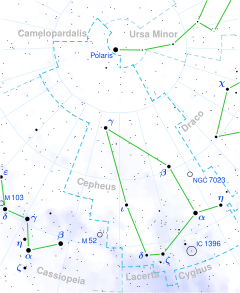Beta Cephei
| Observation data Epoch J2000 Equinox J2000 |
|
|---|---|
| Constellation | Cepheus |
| Right ascension | 21h 28m 39.59685s |
| Declination | +70° 33′ 38.5747″ |
| Apparent magnitude (V) | 3.16 – 3.27 |
| Characteristics | |
| Spectral type | B1 IV |
| U−B color index | –0.95 |
| B−V color index | –0.22 |
| Variable type | β Cep |
| Astrometry | |
| Radial velocity (Rv) | –8.2 km/s |
| Proper motion (μ) |
RA: +12.54 mas/yr Dec.: +8.39 mas/yr |
| Parallax (π) | 4.76 ± 0.30mas |
| Distance | 690 ± 40 ly (210 ± 10 pc) |
| Absolute magnitude (MV) | –3.03 |
| Details | |
| Mass | 12.2 – 19.5 M☉ |
| Radius | 5.6 R☉ |
| Luminosity | 15,100 L☉ |
| Surface gravity (log g) | 4.05 cgs |
| Temperature | 27,000 K |
| Metallicity [Fe/H] | –0.23 dex |
| Rotational velocity (v sin i) | 28 km/s |
| Age | 8.7 Myr |
| Other designations | |
| Database references | |
| SIMBAD | data |
Coordinates: ![]() 21h 28m 39.60s, +70° 33′ 39.0″
21h 28m 39.60s, +70° 33′ 39.0″
Beta Cephei (β Cephei, abbreviated Beta Cep, β Cep), also named Alfirk, is a third magnitude star in the constellation of Cepheus. It is the prototype of the Beta Cephei variable stars.
β Cephei (Latinised to Beta Cephei) is the star's Bayer designation.
It bore the traditional name Alfirk, derived from the Arabic الفرقة al-firqah "the flock" (of sheep). This star, along with Alpha Cephei (Alderamin) and Eta Cephei (Alkidr), were Al Kawākib al Firḳ الكوكب الفرق "the stars of the flock" by Ulug Beg. In 2016, the International Astronomical Union organized a Working Group on Star Names (WGSN) to catalogue and standardize proper names for stars. The WGSN approved the name Alfirk for this star on 21 August 2016 and it is now so entered in the IAU Catalog of Star Names.
Like the star Epsilon Draconis in the constellation of Draco, Alfirk is visible primarily in the northern hemisphere, given its extreme northern declination of 70 degrees and 34 minutes. The star is nevertheless visible to most observers throughout the world reaching as far south as cities like Harare in Zimbabwe, Santa Cruz de la Sierra in Bolivia or other settlements north ± 19° South latitude. The star is circumpolar throughout all of Europe, northern Asia, and North American cities as far south as Guadalajara in west central Mexico. All other locations around the globe having a latitude greater than ± 20° North will notice that the star is always visible in the night sky. Because Beta Cephei is a faint third magnitude star, it may be difficult to identify in most light polluted cities, though in rural locations the star should be easily observable.
...
Wikipedia

